True baseball card collectors know all about the 1963 Topps Pete Rose rookie card.
One of the most iconic baseball cards of all-time, the rookie card of baseball’s all-time hit king is arguably one of the most important pieces to any collection, especially if you are a Pete Rose or Cincinnati Reds fan.
And it’s not hard to understand why collectors want this card: Pete Rose is one of the greatest players to ever play the game. His hit total of 4,256 remains an all-time record, plus he also owns all-time records in games played (3,562), plate appearances (15,890), and at-bats (14,053).
While not in the Baseball Hall of Fame for his off-the-field controversies, Pete Rose is understandably one of the best players of all time. Naturally, his rookie card commands high prices and is highly sought after.
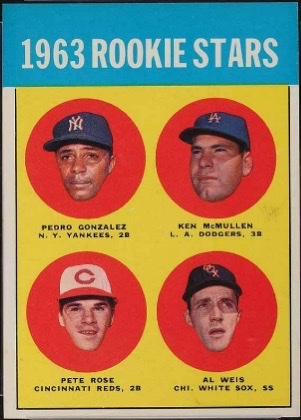
The 1963 Topps #537 is not a difficult card to locate, but it can be expensive to purchase on the secondary market. A mid-grade copy of the card is going for around $2,000 these days, with high grade copies going well into five figures, some even six figures. One PSA Mint 9 copy of the card sold for $116,100 back in February 2021.
One curious aspect of the Pete Rose rookie (and other similar “Rookie Stars” inserts of this era) is the presence of three other rookies on the card. Obviously collectors seek the 1963 card #537 for the Pete Rose appearance. But what about the other three rookies?
What about Pedro Gonzalez, Ken McMullen, and Al Weis?
Here’s a quick roundup of the other guys on the 1963 Pete Rose rookie, including a brief overview of their other baseball card appearances.
Pedro Gonzalez, 3B (Yankees)
Dominican baseball player Pedro Gonzalez made his debut with the New York Yankees at age 25 in 1963 and did not have a great first impression. He batted .192 in his first 14 games before being sent down to the minor leagues for the rest of the season. His 2nd season with New York was considerably better, batting .277 in 80 games with nine extra-base hits, but it wasn’t enough for the Yankees to keep him around. He was traded to Cleveland in May of 1965.
Gonzalez would play the rest of his career for the Indians, which was only three years of major league baseball, followed by four more years of minor league baseball until he ended his career at age 33. He finished with a .244 career batting average, collecting 264 hits in 1,171 plate appearances.
Not exactly an impressive professional career, but he does have the distinction of being one of the first Dominican baseball players to play in Major League Baseball.
Gonzalez had several more cards in Topps sets after 1963, including another Rookie Stars insert in the 1964 set. His last card with the Yankees was 1965 card #97 and his first card with the Cleveland Indians was 1966 card #266.
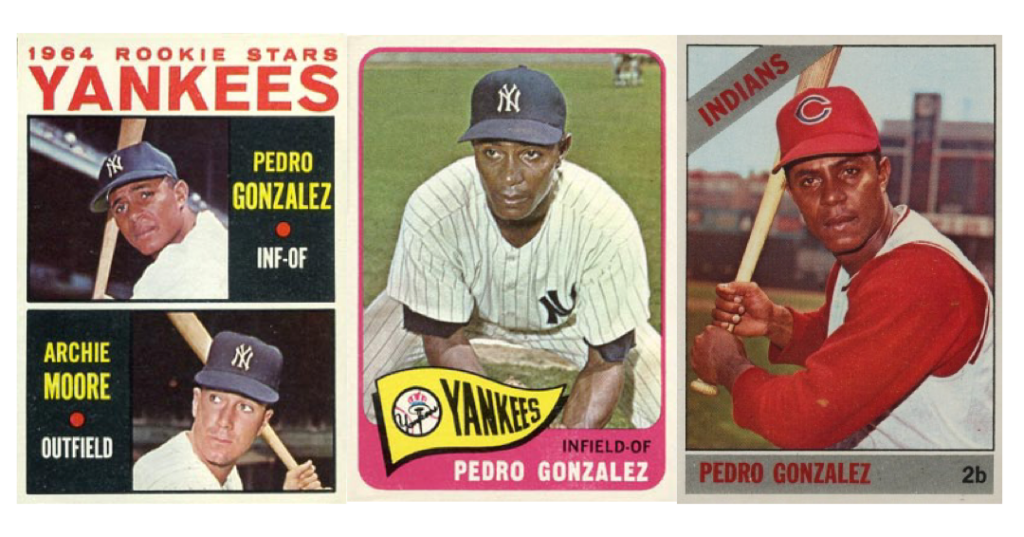
His fifth and final Topps baseball card was 1967 card #424 with Cleveland. Outside of the 1963 Topps #537, none of Gonzalez’s cards are that costly to obtain, typically just a few dollars.
Ken McMullen, 3B (Dodgers)
Ken McMullen had probably the most accomplished career of any rookie on the 1963 Topps #537 not named Pete Rose. He played for five different Major League Baseball teams across 16 years, finishing with 156 home runs in 1,583 career games.
At first McMullen wasn’t an impressive third baseman in the field, something he would have to make up for with his bat. And unfortunately, his bat just wasn’t good enough for most teams to hang on to him for more than a few years. His longest stint came with the Washington Senators between 1965 and 1969, where he slashed .251/.317/.389, hit 86 home runs, and collected 327 RBI. While in Washington, he improved his defense significantly, becoming one of the better defensive fielders in the league for a time.
Probably the highlight of McMullen’s career is being on the 1963 World Series Champion Los Angeles Dodgers roster, however he was unable to play in the series against the Yankees due to a hamstring injury. McMullen finished his career primarily as a spot starter and pinch hitter for the Dodgers, Athletics, and Brewers.
McMullen was featured in Topps baseball card sets every year between 1963 and 1977.
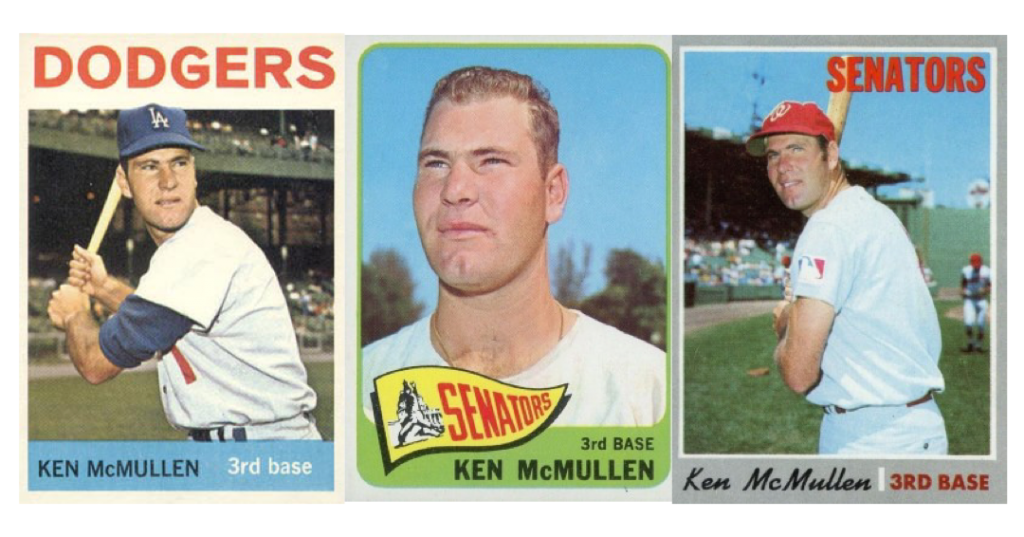
His first non-rookie card with the Dodgers was 1964 Topps card #214. He had several cards with the Washington Senators, the first of which was 1965 card #319 and the last of which was 1970 card #420. Most of these can be purchased for around $10-15 raw and around $50 in high grade condition.
His final Topps card was 1977 card #181, a design which featured the familiar Topps’ facsimile autograph on the lower half of the front of the card.

While obviously McMullen is no Pete Rose, he did have a substantial MLB career and one that any baseball player would be proud of. He was arguably the Washington Senators’ best position player for three years between 1967 and 1969 and his 21.2 WAR (wins above replacement) ranks 16th all-time in the Washington Senators/Texas Rangers franchise.
Al Weis, SS (White Sox)
Al Weis was featured in several more Topps sets after the 1963 Rookie Stars card #357, including 1964 card #168 “All-Star Rookie”, 1966 card #66, and 1971 card #751, his last baseball card, which was also a short print.
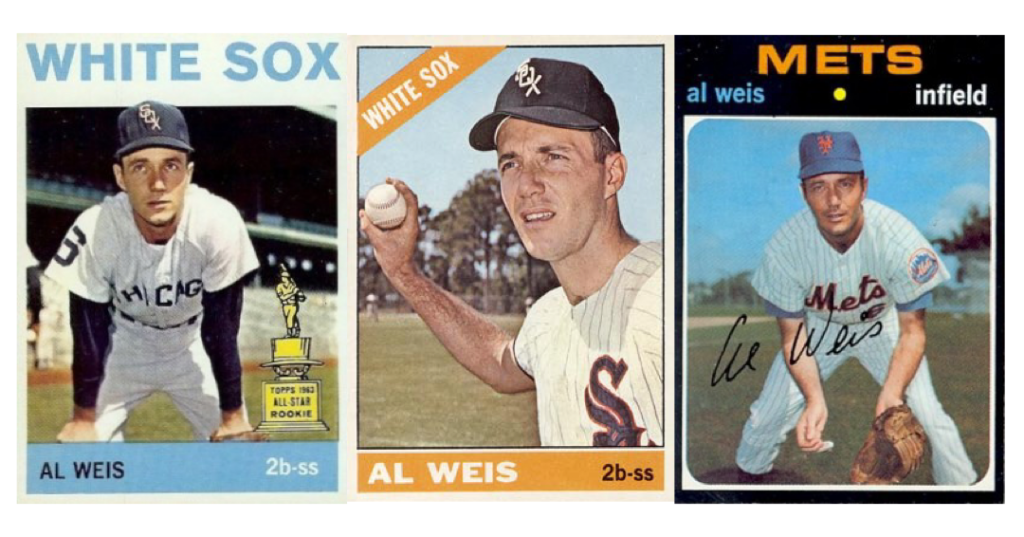
Weis, who was not known for his power, hit a dramatic home run in Game 5 of the 1969 World Series between the Mets and Orioles. With the Mets down 3-2 in the 7th inning, Weis hit a long home run to left field to tie the game. The Mets would then score two more runs in the 8th, on their way to an improbable World Series victory.
That was the only postseason home run of Al Weis’s career, and it became immediately legendary in the context of what the New York Mets did that summer and what Al Weis’s career looked like to that point.
The Mets were not expected to do much of anything in the 1969 season. Finishing almost dead last in the National League in 1968, the Mets completely turned things around in 1969, winning 100 games behind pitching power tandem Tom Seaver and Jerry Koosman (featuring a 2nd year relief pitcher from Texas named Nolan Ryan), plus a balanced lineup of crafty hitters like Ken Boswell, Cleon Jones, and Tommie Agee.
It was an unthinkable turnaround for the Mets, a team that had never finished higher than 9th in the NL since joining the league in 1962.
Unthinkable. Improbable. Impossible.
Almost as unthinkable, improbable, and impossible as a guy with seven career home runs hitting his first ever postseason home run to tie the game, leading the rally and helping the Mets capture their first ever World Series.
No one saw the Al Weis home run coming, much like no one saw the 1969 Mets coming.
Al Weis cards are not that hard to find and are fairly cheap to acquire. His 1969 Topps #269 with the Mets is among his most popular cards, as you might expect. Raw copies of the card sell for around $10 in mid-grade condition.
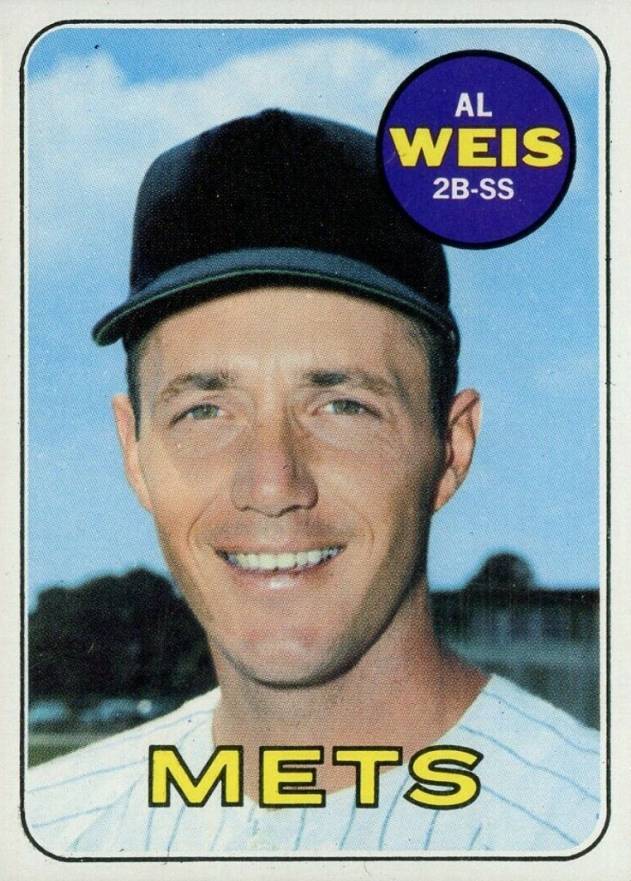
A PSA Mint 9 copy of an Al Weis 1969 Topps #269 sold for $315 in February 2021, which is the highest sale of any Al Weis card in history (other than the 1963 Rookie Stars #357). High grade copies of his 2nd year cards from 1964 and his first New York Mets cards from 1968 go for only around $100.
Perhaps the best part of baseball card collecting are the stories behind the cards themselves. With most people focused on Hall of Famers and household names, there are thousands of baseball players with stories like Al Weis and Ken McMullen. And all of them have cards to collect which help paint the picture of their less-heralded, but still impactful, MLB careers.
Most of them do not have the same rookie card as one of the best baseball players of all time, but that’s just what makes Pedro Gonzalez, Ken McMullen, and Al Weis stand out from the rest.
Sources: baseball-reference.com, Vintage Card Prices.com
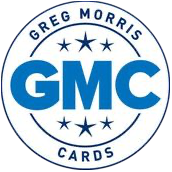

1 thought on “What about those other guys on the 1963 Topps Pete Rose rookie?”
I have collected and owned most of the cards spotlighted here — except the Rose rookie, of course. These other players were commons that form the heart and soul of an avid collector’s card collection. As such, I have a warm feeling for Pedro, Ken and Al. And like every 8th grader who followed baseball in 1969, I was absolutely astounded by the Weiss HR in Game 5. But aren’t such anomolies part of what makes baseball so special in general and the World Series in particular? I certainly think so!